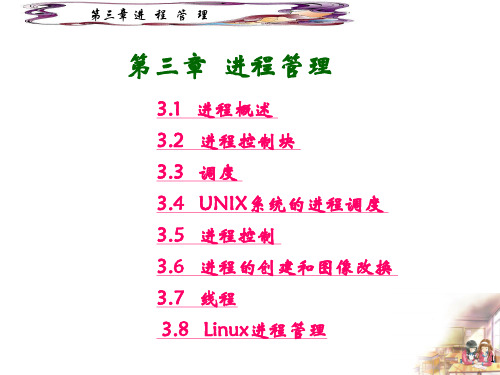《操作系统原理》PPT课件
合集下载
操作系统原理第三章ppt课件

多道程序系统中程序执行环境的变化
程序内保持 Ii→Ci→Pi 程序逻辑顺序性。
I1
I2
I3
存在Ii→Ii+1;Ci→Ci+1; Pi→Pi+1; 表明系统资源竞
C1
C2
C3
争带来顺序性前驱关系。
P1
P2
P3
不同程序之间 Ii+2、Ci+1 和Pi ,没有前
驱关系,说明可以并发执行,这是系统的并
清华大学出版社
3.1 多道程序设计
下一 步
1/8Δt = 0.125道程序/Δt
A吞,吐B,率C分,D别为为程: 序1/8,=忽0.略12外5 设; 假2/9定=40个.2程22序 都Δ44道道/t1提需时1程高运=间序了0行情,.近3况2在633个比期倍单。 间显然有不6个仅使Δt内时存
A
0 Δt 1
32进程的概念321前驱图和程序执行清华大学出版社对于图34对于任意程序存在着iicipi这样的前驱关系因而对一个用户程序的输入计算和打印这三个操作必须顺序执行但在多道环境下并不存在或并不要求piii1关系即iicj和pkijk之间并不存在前驱关系因而在对一批程序处理时可使它们并发执行
第3章 操作系统概述
发性,提高 (9-5)/9x100%清=华4大4%学。出版社
3.2 进程的概念
3.2.1 前驱图和程序执行
应当说明,抛开典型的I、C、 P关系,一个程序内部语句之
S0:x = a+10; S1:y = b - a; S2:z = x+y-10;
间在并发环境下依然有并发执
S3:print(z);
行的情况,如4条语句构成的 程序段:
清华大学出版社
操作系统原理课件

次只有一道程序,因此各个程序是按次序执 行的,即执行完一个以后,再执行下一个。 (2)封闭性:独占全部资源,计算机的状态只 由于该程序的控制逻辑所决定 (3)可再现性:结果的再现性,初始条件相同 则结果相同。
4
第三章 进 程 管 理
程序的并发执行及其特征
1. 程序的并发执行
I1
I2
I3
I4
C1
C2
① 进程状态,指明进程的当前状态, 作为进程调度和对 换时的依据;
② 进程优先级,用于描述进程使用处理机的优先级别的一 个整数, 优先级高的进程应优先获得处理机;
③ 进程调度所需的其它信息,它们与所采用的进程调度算 法有关,比如,进程已等待CPU的时间总和、 进程已执 行的时间总和等;
26
第三章 进 程 管 理
PCB随进程的创建而填写,随进程的撤消而释放; 系统利用PCB来控制和管理进程,所以PCB是系统感 知进程存在的唯一标志 进程与PCB是一一对应的 PCB结构常驻内存;系统将所有PCB组织成若干个队 列,存放在操作系统中专门开辟的PCB区内。
27
第三章 进 程 管 理
2. 进程控制块中的信息
2.共享正文段 用高级语言编写的程序一般是可重入的“纯代
码”,也即是它可以被多个进程并发地执行的。 共享正文段不限于包括程序,还可包括不可修改
的常数。 用户用C语言所编的程序经编译后产生的代码也
是作为共享正文段装入内存的
18
第三章 进 程 管 理
3.数据区 进程执行时用到的数据,如C程序中的外部变量
2
第三章 进 程 管 理
程序 1. 程序:是一个在时间上严格有序的指令集合。 2. 程序规定了完成某一任务时,计算机所需做
的各种操作,以及这些操作的执行时间。 3. 程序的顺序执行:具有独立功能的程序独占
4
第三章 进 程 管 理
程序的并发执行及其特征
1. 程序的并发执行
I1
I2
I3
I4
C1
C2
① 进程状态,指明进程的当前状态, 作为进程调度和对 换时的依据;
② 进程优先级,用于描述进程使用处理机的优先级别的一 个整数, 优先级高的进程应优先获得处理机;
③ 进程调度所需的其它信息,它们与所采用的进程调度算 法有关,比如,进程已等待CPU的时间总和、 进程已执 行的时间总和等;
26
第三章 进 程 管 理
PCB随进程的创建而填写,随进程的撤消而释放; 系统利用PCB来控制和管理进程,所以PCB是系统感 知进程存在的唯一标志 进程与PCB是一一对应的 PCB结构常驻内存;系统将所有PCB组织成若干个队 列,存放在操作系统中专门开辟的PCB区内。
27
第三章 进 程 管 理
2. 进程控制块中的信息
2.共享正文段 用高级语言编写的程序一般是可重入的“纯代
码”,也即是它可以被多个进程并发地执行的。 共享正文段不限于包括程序,还可包括不可修改
的常数。 用户用C语言所编的程序经编译后产生的代码也
是作为共享正文段装入内存的
18
第三章 进 程 管 理
3.数据区 进程执行时用到的数据,如C程序中的外部变量
2
第三章 进 程 管 理
程序 1. 程序:是一个在时间上严格有序的指令集合。 2. 程序规定了完成某一任务时,计算机所需做
的各种操作,以及这些操作的执行时间。 3. 程序的顺序执行:具有独立功能的程序独占
Windows操作系统原理讲座精品PPT课件

交互式分时处理
•一台计算机,多个便宜终端 - 所有用户可与系统立即交互 - 调试比较方便
•磁盘便宜,故可在线存放程序和数据 - 1 张穿孔卡片 = 100个字节 - 1 MB = 10K卡片 - OS/360 有若干英尺长度的卡片
•新问题 - 易于使用,提高人的生产力 - 合理的响应时间 - 引入文件系统,使用户可存取数据
操作系统特征
共享:
操作系统与多个用户的程序 共同使用计算机上的资源
操作系统特征
随机性:
操作系统必须随时对以不可预测的 次序发生的事件进行响应
考虑周密、设计适当
1.4 操作系统的发展
操作系统发展是随着计算机硬件 技术的发展而发展的 目标:充分利用硬件
1.4.1 概述
操作系统历史划分为4个阶段
ቤተ መጻሕፍቲ ባይዱ
第 0 阶段 硬件非常昂贵,没有操作系统
增加:存储保护,重定位 利用率高(多个作业) 有必要采用并发程序设计技术 操作系统成为研究焦点:需要处理复杂
性
•首次面对重大失败:
- MULTICS 于 1963 年开始, 直至 1969 年才发布
- IBM 的 OS/360 发布时, 带着已知的 1000 个错误
•早期计算机:单控制方式
- CPU负责计算,也负责传输
控制台
一个用户
• 一次完成一个功能(计算,I/O,用 户思考/反应)
• 程序通过卡片装入 • 用户在控制台前调试程序
•工作效率非常低
•每一用户都要自行编写涉及到硬件的 源代码
•工作量大,难度高,易出错,需要 大量人力和物力
第 1 阶段 硬件昂贵,人力便宜
简单批处理:装入程序、运行、打印 结果、撤出、再重复 •用户把程序(卡片或磁带)交给负责
•一台计算机,多个便宜终端 - 所有用户可与系统立即交互 - 调试比较方便
•磁盘便宜,故可在线存放程序和数据 - 1 张穿孔卡片 = 100个字节 - 1 MB = 10K卡片 - OS/360 有若干英尺长度的卡片
•新问题 - 易于使用,提高人的生产力 - 合理的响应时间 - 引入文件系统,使用户可存取数据
操作系统特征
共享:
操作系统与多个用户的程序 共同使用计算机上的资源
操作系统特征
随机性:
操作系统必须随时对以不可预测的 次序发生的事件进行响应
考虑周密、设计适当
1.4 操作系统的发展
操作系统发展是随着计算机硬件 技术的发展而发展的 目标:充分利用硬件
1.4.1 概述
操作系统历史划分为4个阶段
ቤተ መጻሕፍቲ ባይዱ
第 0 阶段 硬件非常昂贵,没有操作系统
增加:存储保护,重定位 利用率高(多个作业) 有必要采用并发程序设计技术 操作系统成为研究焦点:需要处理复杂
性
•首次面对重大失败:
- MULTICS 于 1963 年开始, 直至 1969 年才发布
- IBM 的 OS/360 发布时, 带着已知的 1000 个错误
•早期计算机:单控制方式
- CPU负责计算,也负责传输
控制台
一个用户
• 一次完成一个功能(计算,I/O,用 户思考/反应)
• 程序通过卡片装入 • 用户在控制台前调试程序
•工作效率非常低
•每一用户都要自行编写涉及到硬件的 源代码
•工作量大,难度高,易出错,需要 大量人力和物力
第 1 阶段 硬件昂贵,人力便宜
简单批处理:装入程序、运行、打印 结果、撤出、再重复 •用户把程序(卡片或磁带)交给负责
windows操作系统原理ppt

对象头部属性
对象名(Object name) 对象目录(directory in which object live) 安全描述字(access security descriptor) 配额使用价格(resource quota charges) 打开把柄记数(open handle counter) 打开把柄数据库(open handle database) 永久/临时(permanent/temporary) 核心/用户模式(kernel/user mode) 访问记数(reference counts) 对象类型指针(type object pointer)
11.3 操作系统体系结构
操作系统组成成分
– 主动成分:进程,线程 – 被动成分:模块,对象
基于共享变量的体系结构 基于消息通讯的体系结构 微内核结构
成分间的关系
1. 主动-主动 主动 消 息 主动 主动 主动
公共变量 2. 主动-被动 主动 主动 主动
被动
被动
被动
成分间的关系
被动-被动 主动 主动 主动
4. 分层原则 (1) 与界面有关的放在高层 (2) 与硬件有关的放在低层 (3) 并发控制放较低层 (4) 其它放在中层
分层实例 6层 5层 4层 3层 2层 1层 0层 SPOOLing系统 作业调度 终端命令
系统调用(OS API) 进程(线程)管理 虚拟存储 内存管理
中断处理 短程调度
高级通讯 文件管理 设备管理
第十一章 操作系统设计
操作系统设计目标 操作系统基本内核 操作系统体系结构
– 基于公共变量的结构 – 基于消息传递的结构 – 微内核结构
操作系统设计方法
– 模块接口法 – 核扩充法 – 层次化方法 – 面向对象方法
操作系统原理课件

目录是文件系统中存储文件信息的数据库,它记录了文件的名字、位置、大小、 创建时间等信息。
目录结构
常见的目录结构有单级目录结构、二级目录结构和多级目录结构。多级目录结构 又称为树形目录结构,它以根目录为起点,各级子目录为分支,构成一棵倒置的 树。
文件操作与访问权限
文件操作
常见的文件操作包括创建文件、打开 文件、读/写文件、关闭文件和删除 文件等。
通过身份认证和权限管理,控制用户对系统资源的访问。
访问控制的实现方式
自主访问控制、强制访问控制、基于角色的访问控制等。
访问控制的应用场景
文件系统保护、网络访问控制、数据库安全等。
加密技术
加密技术的基本概 念
通过加密算法将明文转换为密文,以保护数据的机密性。
加密技术的分类
对称加密、非对称加密、混合加密等。
访问权限
为了保护文件的安全性和完整性,操 作系统通常会对文件的访问权限进行 控制。访问权限一般分为读权限、写 权限和执行权限三种。
文件共享与保护机制
文件共享
多个用户或进程可以同时访问同一个文件,这称为文件的共 享。为了实现文件共享,操作系统需要提供相应的共享机制 ,如基于索引节点的共享方式。
文件保护
根据进程的服务时间进行调度,服务时间短的进程优先得到服务。
优先级调度算法
根据进程的优先级进行调度,优先级高的进程优先得到服务。
时间片轮转(RR)调度算法
将CPU时间划分为固定大小的时间片,每个进程分配一个时间片,轮 流执行。
进程同步与通信
进程同步
多个进程在执行过程中需要协调其推进速度,以保证正确的执行顺序和结果。常见的同步 机制有信号量、管程和消息传递等。
为了防止对文件的非法访问和破坏,操作系统需要采取一定 的保护措施。常见的文件保护机制有口令保护、加密保护和 访问控制列表(ACL)等。
目录结构
常见的目录结构有单级目录结构、二级目录结构和多级目录结构。多级目录结构 又称为树形目录结构,它以根目录为起点,各级子目录为分支,构成一棵倒置的 树。
文件操作与访问权限
文件操作
常见的文件操作包括创建文件、打开 文件、读/写文件、关闭文件和删除 文件等。
通过身份认证和权限管理,控制用户对系统资源的访问。
访问控制的实现方式
自主访问控制、强制访问控制、基于角色的访问控制等。
访问控制的应用场景
文件系统保护、网络访问控制、数据库安全等。
加密技术
加密技术的基本概 念
通过加密算法将明文转换为密文,以保护数据的机密性。
加密技术的分类
对称加密、非对称加密、混合加密等。
访问权限
为了保护文件的安全性和完整性,操 作系统通常会对文件的访问权限进行 控制。访问权限一般分为读权限、写 权限和执行权限三种。
文件共享与保护机制
文件共享
多个用户或进程可以同时访问同一个文件,这称为文件的共 享。为了实现文件共享,操作系统需要提供相应的共享机制 ,如基于索引节点的共享方式。
文件保护
根据进程的服务时间进行调度,服务时间短的进程优先得到服务。
优先级调度算法
根据进程的优先级进行调度,优先级高的进程优先得到服务。
时间片轮转(RR)调度算法
将CPU时间划分为固定大小的时间片,每个进程分配一个时间片,轮 流执行。
进程同步与通信
进程同步
多个进程在执行过程中需要协调其推进速度,以保证正确的执行顺序和结果。常见的同步 机制有信号量、管程和消息传递等。
为了防止对文件的非法访问和破坏,操作系统需要采取一定 的保护措施。常见的文件保护机制有口令保护、加密保护和 访问控制列表(ACL)等。
操作系统原理演示课件.ppt

1、进程同步的概念
进程运行中的两种制约关系 由于竞争资源形成的间接制约关系; 由于相互合作造成的直接制约关系;
进程同步指多个相关进程在执行次序上的协 调
2、临界资源与临界区
临界资源(critical source)
在一段时间内只允许有限个进程访问的资源 ,如 打印机等I/O设备,缓冲区等
其中:缓冲区是临界资源,而访问缓冲区的代码 是临界区
3、信号量机制
引例:生产者-消费者问题 分析:首先需要定义产品的类型,缓冲区的
长度,读写指针,资源变量counter。 Int n; Int in,out; Structure item; Item buffer[n]; Int counter;
3、信号量机制
Void procedure(){
while(true){
生产一个产品放入 nextp;
wait(mutex);
while(counter==n){no-op;}
buffer[in]=nextp;
in++;
counter++;
single(mutex);}
}
3、信号量机制
3、信号量机制
Void procedure(){
while(true){
生产一个产品放入 nextp;
while(counter==n){no-op;}
buffer[in]=nextp;
in++;
counter++;}
}
3、信号量机制
- 1、下载文档前请自行甄别文档内容的完整性,平台不提供额外的编辑、内容补充、找答案等附加服务。
- 2、"仅部分预览"的文档,不可在线预览部分如存在完整性等问题,可反馈申请退款(可完整预览的文档不适用该条件!)。
- 3、如文档侵犯您的权益,请联系客服反馈,我们会尽快为您处理(人工客服工作时间:9:00-18:30)。
Shared variable: int total : = 0 ;
p0,p1:
{
int count;
for (count=1; count <=50; count++)
total = total + 1 ;
} total可能的结果? 最大值?最小值? 注意total是两个进程都可以访问的共享存储单元,不同于一般 程序中的全局变量
Monolithic:内核中所有的子系统运行在相同的特 权级(privileged mode),拥有相同的地址空间,通 信采用常规C函数调用的形式。
5
四、操作系统的硬件支持
▪ 特权级(区分OS与应用程序的权限) ▪ MMU ▪ Cache ▪ 中断
6
五、系统调用
▪ 操作系统提供给应用程序的一个接口,使得应用程序能够获得 操作系统的服务
✓ 一次只能由一个进程访问的资源 临界区(critical section)
✓ 访问临界资源的代码段称为临界区(CS)
13
互斥(mutual exclusion) ✓在一个时刻最多只有一个进程在临界区
同步(synchronization) ✓协调需要访问临界资源的进程,否则会导致race condition (竞争条件) 如:两进程 p0,p1,都通过下面的代码访问一个共享的存储单 元:
进程中的线程共享进程资源,但拥有私有堆栈及线程控制 块(TCB,存储寄存器值、优先级及其他线程状态信息) 核心级线程(KLT:kernel-level thread) ✓ 应用程序通过API调用核心线程管理例程(kernel thread
facility)来管理: 需要进行模式切换
✓ 是OS调度的基本单位 ✓ 线程阻塞不会导致整个进程的阻塞 ✓ 在多处理器环境下,内核可使线程在不同的处理器上
进程是资源拥有的基本单位(unit of resource ownership)
CPU、存储空间,及其他资源(I/O设备、文件等) ▪ 进程控制块(PCB)及其管理 ▪ 进程的状态:running,ready,blocked,stopped,zombie
8
二、线程(thread)
Thread – an execution path in a process Thread – the unit of dispatching
Operating System Principles
操作系统概述 进程管理 存储管理 文件系统与I/O
1
精选课件ppt
第一部分 操作系统概述
一、操作系统的功能
▪ 实现对计算机资源的管理 (CPU, 存储器,I/O设备) ▪ 控制应用程序的执行 ▪ 提供应用程序访问计算机资源的接口(系统调用) ▪ 实现对操作系统内核及应用程序的保护
(quoting Linus Torvalds):
... message passing as the fundamental operation of the OS is just an exercise in computer science masturbation. It may feel good, but you don't actually get anything DONE.
操作系统给计算机一个灵活的大脑、 一个强健的心脏和突出的个性
2
二、OS的分类
批系统 (batch system) ➢ 成批提交作业,作业完成或无法继续执行时发生切换
交互(分时)系统(interactive, Time-sharing system) ➢ 多个用户(应用程序)分享计算机资源 Windows, Linux, …
▪ 进程管理、文件管理、存储管理、系统管理等
▪系统调用是一个复杂的 过程 ▪系统调用往往通过软中 断的方式实现 ▪系统调用在为应用程序 提供操作系统服务的同 时,也实现了对计算机 资源和应用程序的保护
7
第二部分 进程管理
一、进程
Process - a program in execution text section, data section, stack, current activity
void *runner(void *param)
{
int upper=atoi(param);
int i;
sum = 0;
if (upper >0)
for ( i = 1; i <=upper; i++)
sum +=i;
pthread_exit(0);
}
12
三、并发控制:互斥与同步 并发(Concurrent) 与并行(Parallel) 临界资源(critical resource)
10
11
#include <pthread.h> #include <stdio.h> int sum; void *runner(void *param); main(int argc, char *argv[]) {
pthread_t tid; pthread_attr_t attr; pthread_attr_init(&attr); //初始化线程属性为缺省属性 pthread_create(&tid,&attr,runner,argv[1]); //创建线程 pthread_join(tid,NULL); //等待线程tid结束 printf(“sum=%d\n”,sum); }
运行 ✓ E.g. windows thread
9
用户级线程(ULT:user-level thread) ✓ 由应用程序自己通过线程库(thread library)来管 理:线程创建、终止、线程间通信,线程调度与 切换 ✓ OS感知不到ULT的存在 ✓ 线程阻塞会导致整个进程的阻塞 ✓ 理论上讲,在任何OS下都可以实现 ✓ 无法利用多处理器
实时系统(Real-time system) ➢ 满足应用的时间约束要求 VxWorks, QNX, …
3
三、操作系统的Leabharlann 系结构▪ 单内核结构( Monolithic, macro-kernel)与微内核结构 (micro-kernel)
孰优?
4
Monolithic vs. micro-kernel
p0,p1:
{
int count;
for (count=1; count <=50; count++)
total = total + 1 ;
} total可能的结果? 最大值?最小值? 注意total是两个进程都可以访问的共享存储单元,不同于一般 程序中的全局变量
Monolithic:内核中所有的子系统运行在相同的特 权级(privileged mode),拥有相同的地址空间,通 信采用常规C函数调用的形式。
5
四、操作系统的硬件支持
▪ 特权级(区分OS与应用程序的权限) ▪ MMU ▪ Cache ▪ 中断
6
五、系统调用
▪ 操作系统提供给应用程序的一个接口,使得应用程序能够获得 操作系统的服务
✓ 一次只能由一个进程访问的资源 临界区(critical section)
✓ 访问临界资源的代码段称为临界区(CS)
13
互斥(mutual exclusion) ✓在一个时刻最多只有一个进程在临界区
同步(synchronization) ✓协调需要访问临界资源的进程,否则会导致race condition (竞争条件) 如:两进程 p0,p1,都通过下面的代码访问一个共享的存储单 元:
进程中的线程共享进程资源,但拥有私有堆栈及线程控制 块(TCB,存储寄存器值、优先级及其他线程状态信息) 核心级线程(KLT:kernel-level thread) ✓ 应用程序通过API调用核心线程管理例程(kernel thread
facility)来管理: 需要进行模式切换
✓ 是OS调度的基本单位 ✓ 线程阻塞不会导致整个进程的阻塞 ✓ 在多处理器环境下,内核可使线程在不同的处理器上
进程是资源拥有的基本单位(unit of resource ownership)
CPU、存储空间,及其他资源(I/O设备、文件等) ▪ 进程控制块(PCB)及其管理 ▪ 进程的状态:running,ready,blocked,stopped,zombie
8
二、线程(thread)
Thread – an execution path in a process Thread – the unit of dispatching
Operating System Principles
操作系统概述 进程管理 存储管理 文件系统与I/O
1
精选课件ppt
第一部分 操作系统概述
一、操作系统的功能
▪ 实现对计算机资源的管理 (CPU, 存储器,I/O设备) ▪ 控制应用程序的执行 ▪ 提供应用程序访问计算机资源的接口(系统调用) ▪ 实现对操作系统内核及应用程序的保护
(quoting Linus Torvalds):
... message passing as the fundamental operation of the OS is just an exercise in computer science masturbation. It may feel good, but you don't actually get anything DONE.
操作系统给计算机一个灵活的大脑、 一个强健的心脏和突出的个性
2
二、OS的分类
批系统 (batch system) ➢ 成批提交作业,作业完成或无法继续执行时发生切换
交互(分时)系统(interactive, Time-sharing system) ➢ 多个用户(应用程序)分享计算机资源 Windows, Linux, …
▪ 进程管理、文件管理、存储管理、系统管理等
▪系统调用是一个复杂的 过程 ▪系统调用往往通过软中 断的方式实现 ▪系统调用在为应用程序 提供操作系统服务的同 时,也实现了对计算机 资源和应用程序的保护
7
第二部分 进程管理
一、进程
Process - a program in execution text section, data section, stack, current activity
void *runner(void *param)
{
int upper=atoi(param);
int i;
sum = 0;
if (upper >0)
for ( i = 1; i <=upper; i++)
sum +=i;
pthread_exit(0);
}
12
三、并发控制:互斥与同步 并发(Concurrent) 与并行(Parallel) 临界资源(critical resource)
10
11
#include <pthread.h> #include <stdio.h> int sum; void *runner(void *param); main(int argc, char *argv[]) {
pthread_t tid; pthread_attr_t attr; pthread_attr_init(&attr); //初始化线程属性为缺省属性 pthread_create(&tid,&attr,runner,argv[1]); //创建线程 pthread_join(tid,NULL); //等待线程tid结束 printf(“sum=%d\n”,sum); }
运行 ✓ E.g. windows thread
9
用户级线程(ULT:user-level thread) ✓ 由应用程序自己通过线程库(thread library)来管 理:线程创建、终止、线程间通信,线程调度与 切换 ✓ OS感知不到ULT的存在 ✓ 线程阻塞会导致整个进程的阻塞 ✓ 理论上讲,在任何OS下都可以实现 ✓ 无法利用多处理器
实时系统(Real-time system) ➢ 满足应用的时间约束要求 VxWorks, QNX, …
3
三、操作系统的Leabharlann 系结构▪ 单内核结构( Monolithic, macro-kernel)与微内核结构 (micro-kernel)
孰优?
4
Monolithic vs. micro-kernel
